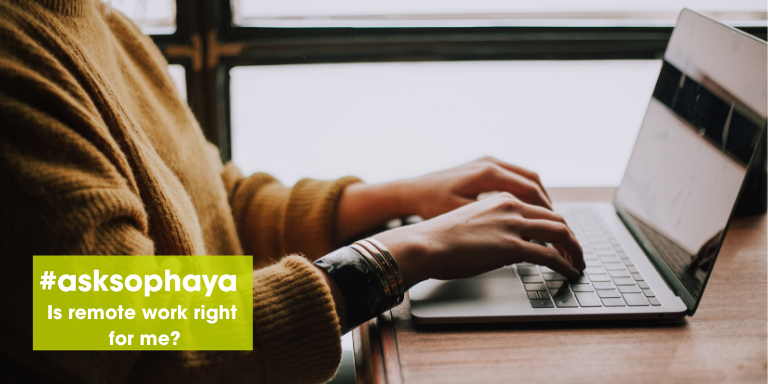Ask Sophaya: What Should I Include In My Employee’s Welcome Kit?

Dear Sophaya,
I’ve been a manager of remote employees for a while now, and I’m ready to initiate some systems now that I’ve really got a handle on how things flow in my agency. We’re going to be hiring a large group of remote employees in the next few months, and I’d like to create a welcome kit to help them get situated. Someone in a traditional job told me they got one of these when they joined a new company and I loved the idea, but I have no clue how to implement it in my organization. Do you have any suggestions of what to include?
Sincerely,
Welcome Woes
Dear Woes,
Creating a welcome kit for your remote team is a wonderful idea for so many reasons. For one, receiving a gift from the company makes employees feel valued at the get-go, which is critical to the success of their onboarding. And a thoughtful onboarding program works wonders for employee retention: According to research from the Society for Human Resources Management, “new employees who attended a structured onboarding program were 69% more likely to remain at the company up to three years.”
What’s more, welcome swag can help serve as free marketing. When your proud employees sport your company merchandise, people notice. It’s a great way to spread your message near and far.
So what’s the best way to implement a remote employee welcome kit or care package? Before we get into ideas for what to include, let’s take a step back and consider where this gift fits in your orientation program.
You mentioned that you’ll be onboarding many new remote workers over the next few months. Depending on the nature of your orientation program, that could mean you’re running several new hire orientations, or one large one where all remote employees attend. Ideally, you’ll want to make sure that your employees have received their welcome kits before the first day of orientation–or, at very worst, that same day. If you conduct any kind of virtual or video-based orientation sessions as a group, this will create a sense of team unity among those who choose to wear your company hat, or sip from the new, branded, eco-friendly water bottle you’ve provided.
Alternatively, are you planning to bring all your new remote staff on-site for their initial orientation and training? If so, you’d be wise to present them with their gifts when they’re on company grounds with you. Truthfully, if you can swing it, I highly recommend this approach. These in-person orientations are where team bonds are founded in truly organic ways. (And it allows all your staff to create memories with the new gifts you’ve provided.)
As for what to include? Start by considering your company mission, vision, and values, as well as the most important things for your employees to take away over the first few weeks. It’s likely that your welcome kit will need to include some educational materials: a brand guide for designers, an editorial guide for copywriters and editors, perhaps some guidelines and restrictions specific to your industry. If you can, try to present these in a way that indicates their significance. Even something as simple as laminating the front covers of documents, for example, makes it less likely that your employees will lose or accidentally damage them.
What will your employees need to do their jobs effectively? Look for opportunities to “personalize” your welcome kits a bit by supplying items that might be specific to your new team’s roles–or that might suit their home offices: fresh pens, pencils, notebooks, and calendars are great options.
From there, you can get creative. For example: Is your company focused on any green initiatives? If so, consider providing your team with a glass, reusable water bottle with your logo. Are you a consumer-product-based company? If so, perhaps you would consider providing your new hires with a branded version of your product.
Depending on your employees’ location and your budget, there are lots of other gifts you can consider branding and including. For example:
- Sunglasses
- Phone cases
- T-shirts, hoodies, and jackets
- Throw blankets
- Shoelaces
- Baseball caps
- Tote bags
Remember: When it comes to branded items, you’ll want to find durable products that your staff will be proud to use in their day-to-day lives.
The thing about welcome kits, though, is they only go so far. For truly effective onboarding, you’ll have to go above and beyond to show your employees you’re invested in their success. Here are a few ideas:
- A handwritten note. It doesn’t have to be long, but a quick note of enthusiasm for your new staff will go far.
- An organizational chart. You can even take this a step further and highlight the staff they’re most likely to interact with.
- An SOS “cheat sheet”. Give them a quick list of important phone numbers, emails, resources, etc. that they can look to if they get stuck.
- A series of one-on-one meetings with colleagues. Okay, this won’t fit in a welcome kit. But while you’re scheduling key appointments or trainings for your employees, consider organizing some one-on-one meetings between your remote team and their new colleagues. It’s a surefire way to help your team feel comfortable.
You absolutely don’t need to use each and every one of these ideas to put together a great welcome kit. Just a small collection of items and a piece of swag or two can make for an easily replicated, yet special welcome gift you can give your new remote team. What’s important is the investment you obviously have in making your team feel cohesive and welcome–and since you’ve nailed that, the rest is sure to follow.
Best of luck!
-Sophaya
